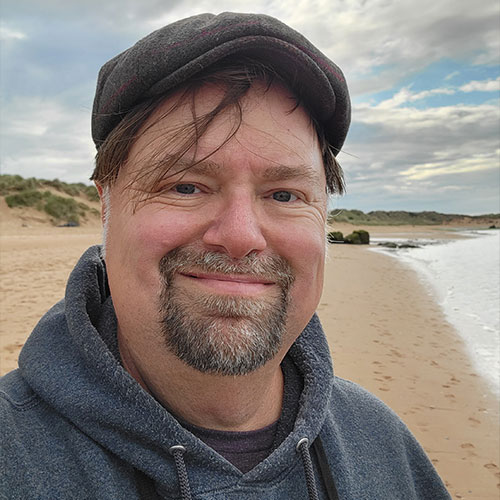
Scott Rainey
Scott Rainey is an 8th-grade teacher at Jemtegaard Middle School in Washougal, Washington. Teaching Early American History, Rainey references his annual East Coast Tour and shares the experiences of his previous students who have gone on tour with him as often as possible. He does so carefully and tactfully, as the East Coast Tour is not sponsored or endorsed by the district, but when teaching about the founding documents of our country, Scott includes in his lessons that these documents are on display at the National Archives and he encourages his students to take the opportunity to see them for themselves.
Why are you passionate about student travel?
My passion for student travel comes from seeing the positive impact on students firsthand. I have traveled with students for 20 years now, and have countless examples of students whose lives have been greatly enriched through travel. I have students who now, as adults, cite their experience of traveling with me as a major factor in why they chose their career paths or place to live. One student recently sent me a video thanking me for the inspiration I gave him as a student traveler, which has led him into a career as a merchant marine where he has now visited dozens of countries and six continents. Another ran up to me at our high school graduation several years ago to tell me that she had just moved into her first apartment after graduating from college – in New York City. To sum up, my favorite quote about traveling is from Mark Twain, and I believe the old riverboat genius sums up my feelings about student travel when he says: Travel is fatal to prejudice, bigotry and narrowmindedness. Charitable views of men and things cannot be obtained by vegetating in one little corner of the earth all one’s lifetime.
What is a major highlight from any of your student travel experiences?
A number of years ago, a family moved to our small, semi-rural Washington State community as refugees from the war in Iraq. Their youngest child, Marcel, was barely six years old and spoke no English. Over the next several years, Marcel, by her own admission, learned to speak English from her friends on the playground at the elementary school. When she was my student in 8th grade, she was a brilliant, driven young woman, who was given the profound gift of getting to go on my East Coast Trip. My two favorite photos of all of my years of traveling are of this brand-new American, standing in front of both the Liberty Bell and the Statue of Liberty. The Liberty Bell of course has emblazoned the words “proclaim liberty throughout all the land” – the liberty her family risked everything to provide for her. And of course, Lady Liberty’s torch welcoming refugees from around the world definitely resonates with Marcel’s experiences. Just two months ago, I was privileged to write Marcel a letter of recommendation for her application to Stanford University. Being able to introduce this amazing young woman to our nation’s history first-hand is one of the greatest privileges of my life.
What is the greatest lesson you or your students have learned from your trips?
In my life, I have always believed that knowledge drives out fear. In my classroom, I explore that concept in many different ways, through simulations, lectures, assignments and writing projects. This then translates very well into student travel. For many of my kids, traveling beyond Washington and Oregon is a foreign concept to them. I use my east coast trip as a chance to show them the truth that the vast majority of people that they are going to meet in different parts of the country (and the world) are good, kind folks who may do things differently from them or may speak differently from them, but at the core, we’re all people, and have much more in common in our humanity that we have different. This is probably the greatest lesson anyone can learn in life – again, going back to the quote from Twain, traveling kills bigotry and narrowmindedness. When you’ve met with, talked with, played with, and eaten with people who are “different” from you, a strange transformation occurs: the “differences” disappear, and all that remains are the friendships. Of course, the differences are still there, but they are no longer something strange and frightening, but instead are beautiful and welcoming.
How do you try to tie your travel experiences back into the classroom?
I see every chance to travel as an opportunity to enrich the classroom experience of my students. Many of my travels stateside have been to locations that we study in my class (early US History, colonization to Reconstruction), and I always bring my camera along to document what I’ve seen and have in mind what might interest my students. For example, I use a photo I took in front of the Customs House in Boston in my lesson on the Boston Massacre, and point out the features in the historic building that exist today that are present in Paul Revere’s famous woodcut of the incident. I also decorate my room with various objects, flags and memorabilia from my travels. An entire wall of my classroom features the four most recent 16×20 prints of our groups in Times Square, and students constantly pore over them looking for older siblings and friends who have traveled with me previously. I also have artwork from the four major Broadway productions my students have seen (The Lion King, Spider-Man: Turn Off the Dark, Wicked and Hamilton) and I even use excerpts from Hamilton in our study of the American Revolution.
From the Nominator:
What qualities make this nominee, both as an educator and travel leader, deserving of this award?
Scott Rainey has been teaching for over 25 years and has been leading an East Coast Tour group since 2004. He’s chaperoned over 1000 students on this transcontinental trip over the past twenty years. Scott models for his students how they can interact with their hosts and fellow travelers, ask questions, and seek out new places and things to explore. He engages his students on multiple levels: not just in the academics of history and writing a persuasive essay on why a student should be chosen as part of the team that lays a wreath at the Tomb of the Unknown Soldier, but he exposes his students to the visual and performing arts and encourages them to embrace the emotions the arts invoke – joy, awe, inspiration, pride, sadness, grief. He takes them to places and helps them draw connections to their lessons; they can stand where historical figures they’ve read about and discussed once stood and see the evidence and artifacts of events that shaped our world. Scott is an active participant in bringing history to life for students. He is so determined to help as many students as he can to participate in this – for some a once-in-a-lifetime – opportunity that he set up a nonprofit to offer scholarships for those who need help to finance their expedition.

